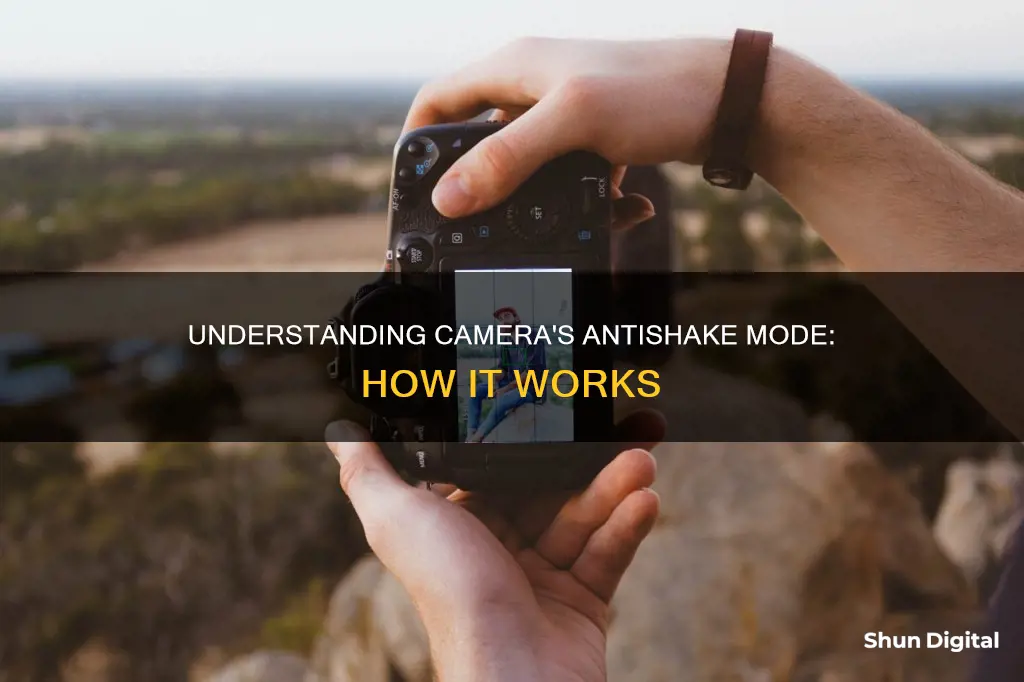
Anti-shake mode, also known as image stabilisation (IS), is a technology used in cameras to reduce the effects of camera movement, thereby preventing blurry photographs. It is particularly useful in low-light settings when it is not possible to use a flash or set up a tripod. There are two main types of anti-shake systems: lens-based and camera-based. The former uses a moving optical element to counteract shaking, while the latter employs a mechanism that allows the image sensor to move and compensate for unwanted movement.
| Characteristics | Values |
|---|---|
| Other Names | Image Stabilization, Vibration Reduction |
| Purpose | Reduce blurring associated with the motion of a camera |
| Use Cases | Stills and video capture |
| Types | Lens-based, Camera-based |
| Lens-based Function | Uses a moving optical element to counteract shaking |
| Camera-based Function | Allows the image sensor to move to compensate for unwanted movement |
| Advantage | Enables slower shutter speed and sharper images |
What You'll Learn

How does anti-shake mode work?
There are two main types of anti-shake systems: lens-based and camera-based. Both are designed to reduce the effects of camera movement, which can cause blurring, especially in low-light conditions.
Lens-based Anti-Shake Systems
Lens-based anti-shake systems use a moving optical element to counteract shaking. This technology is implemented in the lens itself, as distinct from in-body image stabilization (IBIS). The key element of all optical stabilization systems is that they stabilize the image projected onto the sensor before the sensor converts the image into digital information. This is achieved by employing a gyroscopically driven "floating" element in the rear portion of the lens that rapidly shifts the element in the opposite direction of the camera movement.
Camera-based Anti-Shake Systems
Camera-based anti-shake systems use a mechanism that allows the image sensor to move to compensate for unwanted movement. The camera sensor is mounted on a "floating" micro-geared stage that rapidly shifts the sensor in the opposite direction of the camera's movement, effectively cancelling out the image movement. This has the advantage of working with all lenses.
Why 18650 Batteries Are Popular in Cameras
You may want to see also

What are the different types of anti-shake systems?
There are two main types of anti-shake systems: lens-based and camera-based. Lens-based anti-shake systems use a moving optical element to counteract shaking, while camera-based anti-shake systems use a mechanism that allows the image sensor to move and compensate for unwanted movement.
Lens-based image stabilization, also known as optical image stabilization (OIS), is a mechanism used in still or video cameras that stabilizes the recorded image by varying the optical path to the sensor. This technology is implemented in the lens itself, as distinct from in-body image stabilization (IBIS), which operates by moving the sensor. The key element of all optical stabilization systems is that they stabilize the image projected onto the sensor before the sensor converts the image into digital information. IBIS can have up to 5 axes of movement: X, Y, Roll, Yaw, and Pitch.
Different companies have different names for their OIS technology, including Vibration Reduction (VR) from Nikon, Image Stabilizer (IS) from Canon, Anti-Shake (AS) from Minolta and Konica Minolta, Optical SteadyShot (OSS) from Sony, MegaOIS and PowerOIS from Panasonic and Leica, and more.
Camera-based anti-shake systems, on the other hand, use a mechanism that allows the image sensor to move and compensate for unwanted movement. This type of stabilization is often referred to as mechanical image stabilization. The sensor is moved to counteract the motion of the camera, maintaining the projection of the image onto the image plane. This technology relies on precise angular rate sensors or gyroscopes to detect camera motion and move the sensor accordingly.
Both lens-based and camera-based anti-shake systems are effective in reducing blur and stabilizing images, with each having its own advantages and disadvantages.
Capturing Sports Action: Keeping Your Camera in Sports Mode
You may want to see also

What are the benefits of anti-shake mode?
The benefits of anti-shake mode are clear: sharper images. Anti-shake technology, also known as image stabilisation, reduces the effects of camera movement, which can cause motion blur. This is particularly useful in low-light situations, where it may not be possible to use a flash or set up a tripod.
There are two main types of anti-shake systems: lens-based and camera-based. Lens-based anti-shake uses a moving optical element to counteract the shaking of the camera. Camera-based anti-shake uses a mechanism that allows the image sensor to move and compensate for unwanted movement. Both types of systems are designed to reduce blur that results from normal, minute shaking of a lens due to handheld shooting.
Anti-shake technology allows photographers to use slower shutter speeds while still achieving acceptably sharp images. This is especially useful in low-light conditions, as it enables photographers to use slower shutter speeds without the need for a tripod. For example, with a 200mm lens, a sharp image can usually be captured at 1/200 second or higher without anti-shake. With anti-shake, it is possible to achieve an acceptably sharp image at shutter speeds up to two full stops under the focal length reciprocal, such as 1/60 second with a 200mm lens.
In addition to improving image sharpness, anti-shake technology can also help reduce the amount of visual 'judder' in videos, making it easier for viewers to track the subject within a scene.
Unleashing Creative Control: Camera Raw Filter's Power
You may want to see also

What are the limitations of anti-shake mode?
Anti-shake mode, also known as image stabilisation, is a feature on many modern cameras that compensates for unwanted movement of the camera, reducing the blurring of photographs. While this technology can be extremely useful, it does have some limitations.
One of the main limitations of anti-shake mode is that it is not effective in all situations. It is designed to reduce blur caused by normal, minute shaking of a lens due to handheld shooting. However, it cannot prevent motion blur caused by extreme movements of the camera or by the movement of the subject. Additionally, anti-shake mode may not work with all lenses, particularly fast primes and wide-angle lenses.
Another limitation of anti-shake mode is that it can introduce optical imperfections. This is because the system temporarily alters the optical path in the lens to compensate for camera shake. As a result, manufacturers recommend that anti-shake mode only be used when necessary and suggest using different operational modes to limit its action depending on the type of picture being taken.
Furthermore, anti-shake mode may not always provide a stable image in the viewfinder, particularly with lens-based stabilisation systems. This can make it challenging to compose and frame your shot accurately. Additionally, anti-shake mode may not be effective with very long telephoto lenses, especially when using slower shutter speeds, as the sensor movement may not be sufficient to compensate for the image displacement.
It is also important to note that anti-shake mode draws battery power, so it is recommended to deactivate it when not needed to extend the battery life. Additionally, some manufacturers suggest turning off the feature when the camera is mounted on a tripod, as it can cause erratic results and is generally unnecessary in that situation.
Finding the Camera Raw Dialog Box
You may want to see also

How does anti-shake mode compare to using a tripod?
Anti-shake mode and the use of a tripod are both methods to reduce camera shake and motion blur in photographs. Camera shake can be caused by the movement of the photographer's hands, the camera itself, or the environment.
Anti-Shake Mode
Anti-shake mode, also known as image stabilisation, is a feature built into some cameras and lenses that compensates for unwanted movement, which would otherwise blur a photograph. There are two main types of anti-shake systems: lens-based and camera-based. Lens-based anti-shake uses a moving optical element to counteract shaking, while camera-based anti-shake uses a mechanism that allows the image sensor to move and compensate for unwanted movement. This technology is particularly useful when shooting handheld, in low-light conditions, or with long focal length lenses. It enables photographers to use slower shutter speeds without introducing motion blur.
Tripod
A tripod is an external device used to stabilise a camera by providing a stable base. It is an effective way to prevent camera shake, especially during long exposures or in low-light situations. When using a tripod, it is recommended to turn off image stabilisation as it can detect and correct movements that are not there, leading to unwanted blur. Additionally, using a remote shutter release or a self-timer can further reduce camera shake by eliminating the need to press the shutter button directly.
Comparison
Both anti-shake mode and using a tripod aim to reduce camera shake and improve image sharpness. Anti-shake mode is a feature built into the camera or lens, while using a tripod is an external solution. Anti-shake mode is particularly useful when shooting handheld or in situations where a tripod is not practical or permitted. On the other hand, a tripod provides a more stable base and is essential for long exposures or low-light photography. Additionally, tripods offer more flexibility in composing and framing shots as they can be adjusted in height and position. However, tripods can be bulky and less convenient to carry around compared to just using a camera with anti-shake mode.
In summary, anti-shake mode and the use of a tripod are both effective tools for reducing camera shake and improving image quality. The choice between the two depends on the specific shooting conditions, the type of camera and lens being used, and the photographer's preferences. In some cases, a combination of both techniques may be utilised to achieve the desired results.
Kodak Camera Battery Exhausted: What's the Fix?
You may want to see also
Frequently asked questions
Antishake mode, also known as Image Stabilization (IS), is a method of reducing the effects of camera movement, which would otherwise blur a photograph.
There are two main types of anti-shake systems: lens-based and camera-based. Lens-based anti-shake uses a moving optical element to counteract shaking, while camera-based anti-shake uses a mechanism that allows the image sensor to move and compensate for unwanted movement.
Image stabilization can be achieved in the lens or in the camera body. In-camera image stabilization is achieved by mounting the camera sensor on a "floating" micro-geared stage that shifts the sensor in the opposite direction of the camera's movement, effectively cancelling out the image movement.
Antishake mode allows you to use slower shutter speeds while hand-holding the camera, enabling sharper images in low-light conditions without the need for a tripod or flash. It also helps reduce "judder" in video footage, making it easier for viewers to track the subject.
While antishake technology can significantly reduce camera shake, it cannot completely eliminate motion blur caused by extreme camera movements or fast-moving subjects. Additionally, it may introduce optical imperfections and increase battery consumption.







